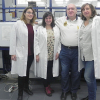
The tomb of Ptahmes, mayor of Memphis in Egypt during the 13th century BC, was initially unearthed in 1885. After being lost under drifting sands, it was rediscovered in 2010, and archaeologists found broken jars at the site a few years later. One jar contained a solidified whitish mass, as well as canvas fabric that might have covered the jar or been used to preserve its contents.
Enrico Greco from the University of Catania and colleagues used liquid chromatography -mass spectrometry (LC-MS) to determine the identity of the contents. The peptides detected by the analysis show the sample was a dairy product made from cow’s milk, and sheep’s or goat’s milk. The characteristics of the canvas fabric, which indicate it was suitable for containing a solid rather than a liquid, and the absence of other specific markers, support the conclusion that the dairy product was a solid cheese.
Other peptides in the food sample suggest it was contaminated with Brucella melitensis, a bacterium that causes brucellosis. This potentially deadly disease spreads from animals to people, typically from eating unpasteurised dairy products. If the team’s preliminary analysis is confirmed, the sample would represent the earliest reported biomolecular evidence of the disease.
The research is reported in Analytical Chemistry.




